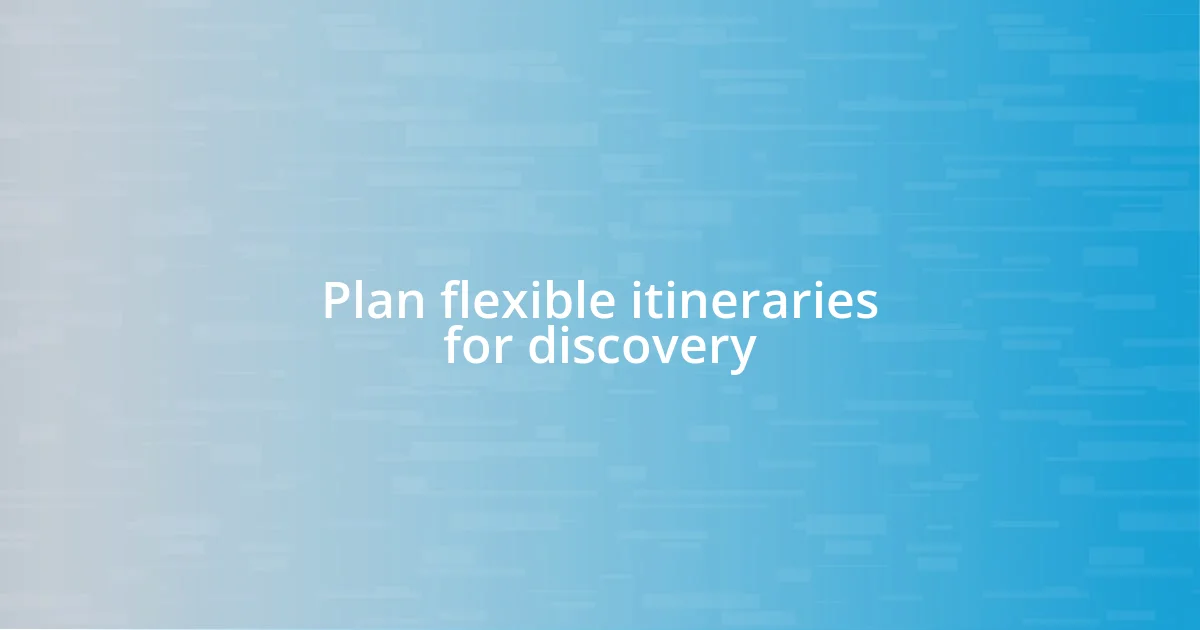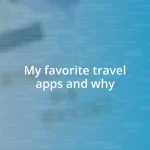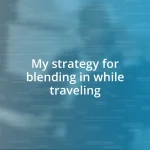Key takeaways:
- Tourist traps are characterized by large crowds, inflated prices, and generic offerings that detract from authentic experiences.
- Researching destinations, seeking local recommendations, and utilizing technology can lead to discovering hidden gems and avoiding tourist traps.
- Being flexible with travel itineraries allows for spontaneous discoveries and deeper connections with local culture and experiences.

Understand tourist trap characteristics
When considering the characteristics of tourist traps, one glaring feature often stands out: the overwhelming crowd. I remember wandering through a bustling square, shoulder to shoulder with fellow travelers, only to find it hard to appreciate what I came to see. Have you ever felt lost in a sea of people, trying to capture that perfect photo but unable to find a moment of peace? That’s a classic sign of a tourist trap.
Another defining trait is the inflated prices. I once bought a simple bottle of water in a popular tourist zone for three times what I’d pay elsewhere, which left me feeling duped. It’s astonishing how some places seem to capitalize on tourists’ willingness to spend. Have you ever checked a menu, only to realize that the food prices were shockingly high simply because of the viewpoint? The allure of a picturesque setting can often blind us to these monetary traps.
Lastly, check for generic offerings. When I visited a so-called local market, every stall seemed to sell the same trinkets and souvenirs that screamed “made for tourists.” This lack of originality often signals a tourist trap. Don’t you crave an authentic experience, one that reflects the local culture instead of a mass-produced imitation? Recognizing these characteristics can dramatically enhance our travel experiences, allowing us to seek out more genuine and enriching destinations.

Research destinations in advance
When I travel, my first step is always research. It’s amazing what you can uncover about a destination’s hidden gems and lesser-known attractions with just a bit of digging online. I recall planning a trip to Barcelona, where I stumbled upon a small tapas bar tucked away from the tourist hordes. That little spot, bursting with locals grabbing after-work bites, became one of my most cherished memories. Have you ever experienced that delightful surprise of finding a place that feels like a closely guarded secret?
Moreover, I find that research helps me understand the best times to visit a location. For instance, I learned that visiting the Louvre during a weekday morning not only meant fewer crowds but also a more serene experience gazing at the Mona Lisa. Again, it comes down to being strategic with your travel plans. How often have you wished you could wander through a captivating site without the constant interruption of selfies being snapped around you?
Lastly, I can’t stress enough the value of reading traveler reviews and blogs. Authentic accounts often reveal practical advice that a standard guidebook doesn’t, such as which side streets to explore for unique encounters or which popular sites to visit at odd hours. I once read about a little-known garden in Kyoto that was breathtakingly beautiful at sunrise. Making my way there before dawn was an effort, but standing there alone amidst cherry blossoms at daybreak felt like discovering a slice of heaven. Isn’t it rewarding to be able to truly experience a place, unfiltered by the rush of tourists?
| Research Strategy | Benefits |
|---|---|
| Online Research | Identify hidden gems and local favorites. |
| Timing Visits | Avoid crowds for a more enjoyable experience. |
| Reading Reviews | Gain practical advice from previous travelers. |

Seek local recommendations and reviews
When I’m exploring a new destination, I always make it a point to chat with locals. Their recommendations often lead me to authentic experiences that you just can’t find in guidebooks or online travel blogs. For example, during a trip to Lisbon, I struck up a conversation with a shop owner who directed me to a cozy fado house that wasn’t on any tourist radar. I’ll never forget the haunting melodies and the warmth of the atmosphere—it felt like stepping into the heart of Portuguese culture. When do you last had someone share an insider tip that truly transformed your travel experience?
- Ask locals for their favorite restaurants, attractions, or hidden gems.
- Look for online community forums where residents recommend places off the beaten path.
- Seek out social media groups centered around the destination for personal insights and recommendations.
Reading recent reviews can also offer a glimpse into the authenticity of a place. I remember checking Yelp before visiting a market in Mexico City. Many reviews pointed out a stand known for its exceptional tacos, complete with mouthwatering photos. After a short trek, I found myself savoring the best tacos of my life, nestled away from the bustling tourist areas. Those genuine reviews made all the difference, and I’m always left wondering how many fleeting moments like that are waiting to be discovered if I just take the time to dig a little deeper.

Explore less popular attractions
Exploring less popular attractions has been a game-changer for my travel experiences. I recall stumbling upon a quaint little sculpture park in a quiet corner of Prague that was almost devoid of tourists. Surrounded by greenery and eclectic art pieces, I felt a connection to the city that far surpassed what I experienced at the more famous sites. Have you ever wandered into a place that instantly took your breath away, simply because no one else was there?
There’s a certain charm in visiting these hidden spots. For instance, while in Florence, I discovered a local artisan market tucked behind the Duomo. It was exhilarating to browse unique handcrafted goods while engaging with the passionate vendors who poured their souls into their crafts. Such encounters resonate far more deeply than the typical souvenirs you find at crowded landmarks. Isn’t it amazing how a simple detour can lead you to experiences that feel truly special?
I often find that these lesser-known sites come with a personal touch that mainstream attractions lack. Recently, I ventured into a small independent museum on the outskirts of Berlin, where passionate volunteers shared fascinating stories about the city’s history. This intimate setting contrasted sharply with my earlier visit to a large, well-known museum that felt sterile and rushed. Which memories stand out more for you—the ones filled with genuine interaction or those lost in a sea of tourists?

Visit during off-peak times
Visiting a tourist destination during off-peak times has drastically changed how I experience a place. I recall one summer in Rome when I decided to wake up before dawn and explore the Colosseum. The early morning light painted everything in a golden hue, and the absence of crowds allowed me to truly appreciate its grandeur. Isn’t it fascinating how the same landmark can feel entirely different when you’re not jostling for space with thousands of others?
I’ve also found that many attractions have different vibes depending on the time of day—or season. There was a trip to the cherry blossom festival in Washington D.C. during peak bloom. I chose to visit on a weekday, expecting to enjoy the serene beauty without the throngs of people that usually overwhelm the weekends. The tranquil atmosphere allowed me to fully engage with the stunning blossoms and even strike up conversations with fellow early risers. Have you ever noticed how peaceful moments can transform your appreciation for a place?
Sometimes, the rewards for visiting during off-peak hours go beyond just fewer faces. When I visited the Louvre on a Wednesday evening, the museum felt almost like a private gallery. The ability to roam freely through the exhibits, spending time with the artworks that resonated with me was truly special. It’s amazing to think about the treasures waiting for us when we shift our perspective and timing. What hidden gems have you discovered by simply avoiding the usual hustle?

Use technology to navigate
Using technology to navigate can make all the difference in avoiding tourist traps. When I travel, I rely heavily on apps like Google Maps or Citymapper to find my way around. Just last summer in Barcelona, I used my phone not only to get to my destination but also to uncover less-frequented routes that revealed stunning views of the city. Isn’t it empowering to have so much information at your fingertips?
Another nifty tool I’ve discovered is TripAdvisor, which I often consult for real-time reviews about attractions and eateries. While visiting Tokyo, I found a ramen shop that didn’t even appear on my food guide but was buzzing with locals. The glowing reviews led me to this hidden gem, and the experience felt exclusive, almost like a local discovering their favorite secret spot! Have you ever found a fantastic place just by checking your smartphone?
I also appreciate using social media platforms like Instagram for inspiration. By searching hashtags specific to the city I’m in, I often uncover quirky spots that aren’t on the usual tourist radar. There’s something thrilling about browsing through images shared by other travelers, like the time I spotted a tiny café in Lisbon through a friend’s post. It turned out to be a charming little place, filled with the aroma of fresh pastries and the laughter of locals. How often do we overlook wonderful experiences we could easily find online?

Plan flexible itineraries for discovery
Flexibility in planning your itinerary can lead to remarkable discoveries. During a spontaneous trip to Amsterdam, I decided to leave part of my schedule open. One afternoon, I ventured down a side street for a quick coffee and stumbled upon a local art gallery filled with captivating works. The deliberate choice to allow for unexpected experiences changed that day from ordinary to unforgettable. Isn’t it incredible how some of the best memories occur when we embrace spontaneity?
I often find that rigid itineraries can lead to missed opportunities. On a recent trip to Paris, I had a full schedule mapped out, but an old friend surprised me with a recommendation for a lesser-known botanical garden. I decided to ditch a touristy museum for an afternoon and was rewarded with serene beauty and a quiet escape that felt like an oasis amidst the city hustle. It reminds me that sometimes, letting go of plans opens doors to extraordinary moments. Have you ever had a similar experience where a detour led to something amazing?
Engaging with locals is one of my favorite ways to find hidden treasures, and it often happens when I’m not fixated on a timeline. While wandering through a village in Italy, I struck up a conversation with a shop owner and learned about a nearby festival that wasn’t on my radar. I shifted my plans to attend, and it turned out to be a highlight of my trip. Those interactions add depth to travel, creating connections that enrich my understanding of a place. What local insights have you uncovered by going with the flow?














